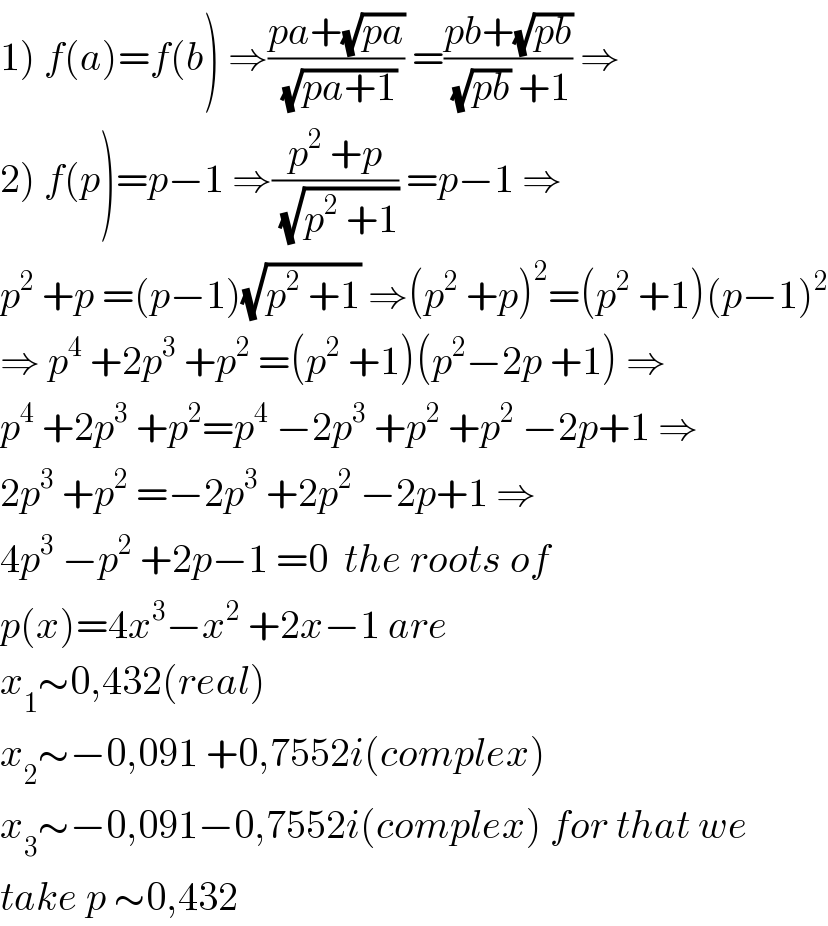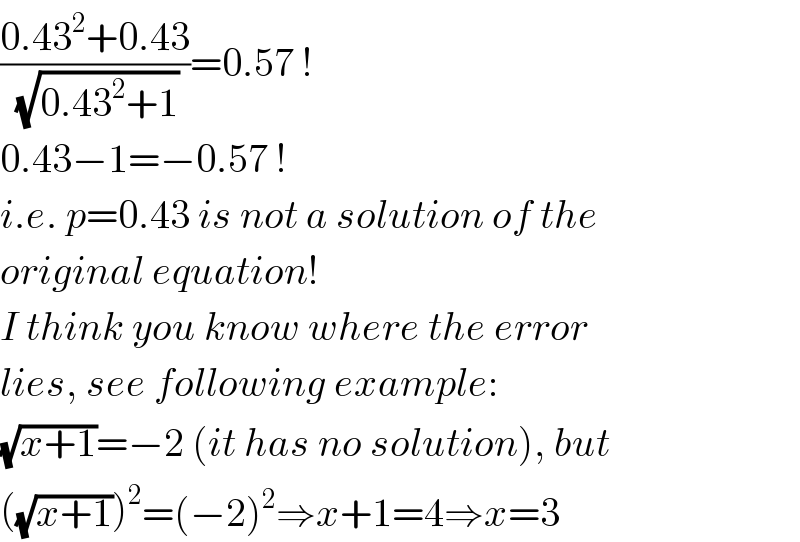Question Number 38533 by behi83417@gmail.com last updated on 26/Jun/18

Commented by math khazana by abdo last updated on 03/Aug/18

$$\left.\mathrm{1}\right)\:{f}\left({a}\right)={f}\left({b}\right)\:\Rightarrow\frac{{pa}+\sqrt{{pa}}}{\:\sqrt{{pa}+\mathrm{1}}}\:=\frac{{pb}+\sqrt{{pb}}}{\:\sqrt{{pb}}\:+\mathrm{1}}\:\Rightarrow \\ $$$$\left.\mathrm{2}\right)\:{f}\left({p}\right)={p}−\mathrm{1}\:\Rightarrow\frac{{p}^{\mathrm{2}} \:+{p}}{\:\sqrt{{p}^{\mathrm{2}} \:+\mathrm{1}}}\:={p}−\mathrm{1}\:\Rightarrow \\ $$$${p}^{\mathrm{2}} \:+{p}\:=\left({p}−\mathrm{1}\right)\sqrt{{p}^{\mathrm{2}} \:+\mathrm{1}}\:\Rightarrow\left({p}^{\mathrm{2}} \:+{p}\right)^{\mathrm{2}} =\left({p}^{\mathrm{2}} \:+\mathrm{1}\right)\left({p}−\mathrm{1}\right)^{\mathrm{2}} \\ $$$$\Rightarrow\:{p}^{\mathrm{4}} \:+\mathrm{2}{p}^{\mathrm{3}} \:+{p}^{\mathrm{2}} \:=\left({p}^{\mathrm{2}} \:+\mathrm{1}\right)\left({p}^{\mathrm{2}} −\mathrm{2}{p}\:+\mathrm{1}\right)\:\Rightarrow \\ $$$${p}^{\mathrm{4}} \:+\mathrm{2}{p}^{\mathrm{3}} \:+{p}^{\mathrm{2}} ={p}^{\mathrm{4}} \:−\mathrm{2}{p}^{\mathrm{3}} \:+{p}^{\mathrm{2}} \:+{p}^{\mathrm{2}} \:−\mathrm{2}{p}+\mathrm{1}\:\Rightarrow \\ $$$$\mathrm{2}{p}^{\mathrm{3}} \:+{p}^{\mathrm{2}} \:=−\mathrm{2}{p}^{\mathrm{3}} \:+\mathrm{2}{p}^{\mathrm{2}} \:−\mathrm{2}{p}+\mathrm{1}\:\Rightarrow \\ $$$$\mathrm{4}{p}^{\mathrm{3}} \:−{p}^{\mathrm{2}} \:+\mathrm{2}{p}−\mathrm{1}\:=\mathrm{0}\:\:{the}\:{roots}\:{of} \\ $$$${p}\left({x}\right)=\mathrm{4}{x}^{\mathrm{3}} −{x}^{\mathrm{2}} \:+\mathrm{2}{x}−\mathrm{1}\:{are} \\ $$$${x}_{\mathrm{1}} \sim\mathrm{0},\mathrm{432}\left({real}\right) \\ $$$${x}_{\mathrm{2}} \sim−\mathrm{0},\mathrm{091}\:+\mathrm{0},\mathrm{7552}{i}\left({complex}\right) \\ $$$${x}_{\mathrm{3}} \sim−\mathrm{0},\mathrm{091}−\mathrm{0},\mathrm{7552}{i}\left({complex}\right)\:{for}\:{that}\:{we} \\ $$$${take}\:{p}\:\sim\mathrm{0},\mathrm{432} \\ $$
Commented by math khazana by abdo last updated on 03/Aug/18

$${p}=\mathrm{0},\mathrm{432}\:{is}\:{not}\:{solution}\:\:{because}\:{p}−\mathrm{1}<\mathrm{0}?{and} \\ $$$$\frac{{p}^{\mathrm{2}} \:+{p}}{\:\sqrt{{p}^{\mathrm{2}} \:+\mathrm{1}}}\:>\mathrm{0}\:\:{so}\:{the}\:{equation}\:{is}\:{impossible}. \\ $$
Answered by behi83417@gmail.com last updated on 27/Jun/18

$$\frac{{p}^{\mathrm{2}} +{p}}{\:\sqrt{{p}^{\mathrm{2}} +\mathrm{1}}}={p}−\mathrm{1}\Rightarrow{p}\left({p}+\mathrm{1}\right)=\left({p}−\mathrm{1}\right)\sqrt{{p}^{\mathrm{2}} +\mathrm{1}} \\ $$$$\Rightarrow{p}^{\mathrm{2}} \left({p}^{\mathrm{2}} +\mathrm{2}{p}+\mathrm{1}\right)=\left({p}^{\mathrm{2}} −\mathrm{2}{p}+\mathrm{1}\right)\left({p}^{\mathrm{2}} +\mathrm{1}\right) \\ $$$$\Rightarrow\mathrm{4}\boldsymbol{{p}}^{\mathrm{3}} −\boldsymbol{{p}}^{\mathrm{2}} +\mathrm{2}\boldsymbol{{p}}−\mathrm{1}=\mathrm{0}\Rightarrow\boldsymbol{{p}}=\mathrm{0}.\mathrm{43}\: \\ $$
Commented by MrW3 last updated on 27/Jun/18

$$\frac{\mathrm{0}.\mathrm{43}^{\mathrm{2}} +\mathrm{0}.\mathrm{43}}{\:\sqrt{\mathrm{0}.\mathrm{43}^{\mathrm{2}} +\mathrm{1}}}=\mathrm{0}.\mathrm{57}\:! \\ $$$$\mathrm{0}.\mathrm{43}−\mathrm{1}=−\mathrm{0}.\mathrm{57}\:! \\ $$$${i}.{e}.\:{p}=\mathrm{0}.\mathrm{43}\:{is}\:{not}\:{a}\:{solution}\:{of}\:{the} \\ $$$${original}\:{equation}! \\ $$$${I}\:{think}\:{you}\:{know}\:{where}\:{the}\:{error} \\ $$$${lies},\:{see}\:{following}\:{example}: \\ $$$$\sqrt{{x}+\mathrm{1}}=−\mathrm{2}\:\left({it}\:{has}\:{no}\:{solution}\right),\:{but} \\ $$$$\left(\sqrt{{x}+\mathrm{1}}\right)^{\mathrm{2}} =\left(−\mathrm{2}\right)^{\mathrm{2}} \Rightarrow{x}+\mathrm{1}=\mathrm{4}\Rightarrow{x}=\mathrm{3} \\ $$
Commented by behi83417@gmail.com last updated on 27/Jun/18

$${thank}\:\:{you}\:{so}\:{much}\:{dear}\:{master}. \\ $$$${you}\:{are}\:{right}.\:{it}\:{should}\:{be}\::{p}>\mathrm{1}. \\ $$
Answered by MrW3 last updated on 27/Jun/18
![f′(x)=(px+(√(px)))(−(p/(2(px+1)(√(px+1)))))+(1/( (√(px+1))))(p+(p/(2(√(px))))) f′(x)=(p/2)[−((√(px))/(px+1))+(1/( (√(px))))] f′(x)=(p/(2(px+1)(√(px)))) f′(x) >0 if p>0 f′(x) <0 if p<0 i.e. f(x) is always increasing or always decreasing. i.e. if f(a)=f(b)⇒a=b⇒(a/b)=1 f(p)=((p^2 +p)/( (√(p^2 +1))))=((p(p+1))/( (√(p^2 +1))))>p but p−1<p ⇒f(p)≠p−1 ⇒no solution for f(p)=p−1](https://www.tinkutara.com/question/Q38565.png)
$${f}'\left({x}\right)=\left({px}+\sqrt{{px}}\right)\left(−\frac{{p}}{\mathrm{2}\left({px}+\mathrm{1}\right)\sqrt{{px}+\mathrm{1}}}\right)+\frac{\mathrm{1}}{\:\sqrt{{px}+\mathrm{1}}}\left({p}+\frac{{p}}{\mathrm{2}\sqrt{{px}}}\right) \\ $$$${f}'\left({x}\right)=\frac{{p}}{\mathrm{2}}\left[−\frac{\sqrt{{px}}}{{px}+\mathrm{1}}+\frac{\mathrm{1}}{\:\sqrt{{px}}}\right] \\ $$$${f}'\left({x}\right)=\frac{{p}}{\mathrm{2}\left({px}+\mathrm{1}\right)\sqrt{{px}}} \\ $$$${f}'\left({x}\right)\:>\mathrm{0}\:{if}\:{p}>\mathrm{0} \\ $$$${f}'\left({x}\right)\:<\mathrm{0}\:{if}\:{p}<\mathrm{0} \\ $$$${i}.{e}.\:{f}\left({x}\right)\:{is}\:{always}\:{increasing}\:{or} \\ $$$${always}\:{decreasing}. \\ $$$${i}.{e}.\:{if}\:{f}\left({a}\right)={f}\left({b}\right)\Rightarrow{a}={b}\Rightarrow\frac{{a}}{{b}}=\mathrm{1} \\ $$$$ \\ $$$${f}\left({p}\right)=\frac{{p}^{\mathrm{2}} +{p}}{\:\sqrt{{p}^{\mathrm{2}} +\mathrm{1}}}=\frac{{p}\left({p}+\mathrm{1}\right)}{\:\sqrt{{p}^{\mathrm{2}} +\mathrm{1}}}>{p} \\ $$$${but}\:{p}−\mathrm{1}<{p} \\ $$$$\Rightarrow{f}\left({p}\right)\neq{p}−\mathrm{1} \\ $$$$\Rightarrow{no}\:{solution}\:{for}\:{f}\left({p}\right)={p}−\mathrm{1} \\ $$
Commented by behi83417@gmail.com last updated on 27/Jun/18

$${dear}\:{master}!{great}\:{job}\:{done}\:{by}\:{you}. \\ $$$${thanks}\:{in}\:{advance}. \\ $$$${is}\:{there}\:{any}\:{chance}\:{to}\:{find}\:\boldsymbol{{f}}^{−\mathrm{1}} \left(\boldsymbol{{x}}\right)? \\ $$
Commented by MrW3 last updated on 27/Jun/18

$${I}\:{see}\:{no}\:{chance}\:{to}\:{find}\:{f}^{−\mathrm{1}} \left({x}\right). \\ $$
Commented by ajfour last updated on 27/Jun/18

$${Can}\:{we}\:{find}\:\theta\:{if} \\ $$$$\mathrm{sin}\:\theta\left(\mathrm{1}+\mathrm{tan}\:\theta\right)={c}\:\:\:\:\:? \\ $$
Commented by behi83417@gmail.com last updated on 27/Jun/18

$${no},{i}\:{think}. \\ $$$${by}\:{putting}:\:\boldsymbol{{px}}=\boldsymbol{{tg}}^{\mathrm{2}} \boldsymbol{\theta},{we}\:{have}\:{the} \\ $$$${equation}:\: \\ $$$$\:\:\:\:\:\:\:\:\:\:\:\:\:\:\:\:\:\:\:\boldsymbol{{sin}\theta}\left(\mathrm{1}+\boldsymbol{{tg}\theta}\right)=\boldsymbol{{y}} \\ $$$$\boldsymbol{{and}}\:\boldsymbol{{solving}}\:\boldsymbol{{this}},\:{not}\:{easy}. \\ $$
